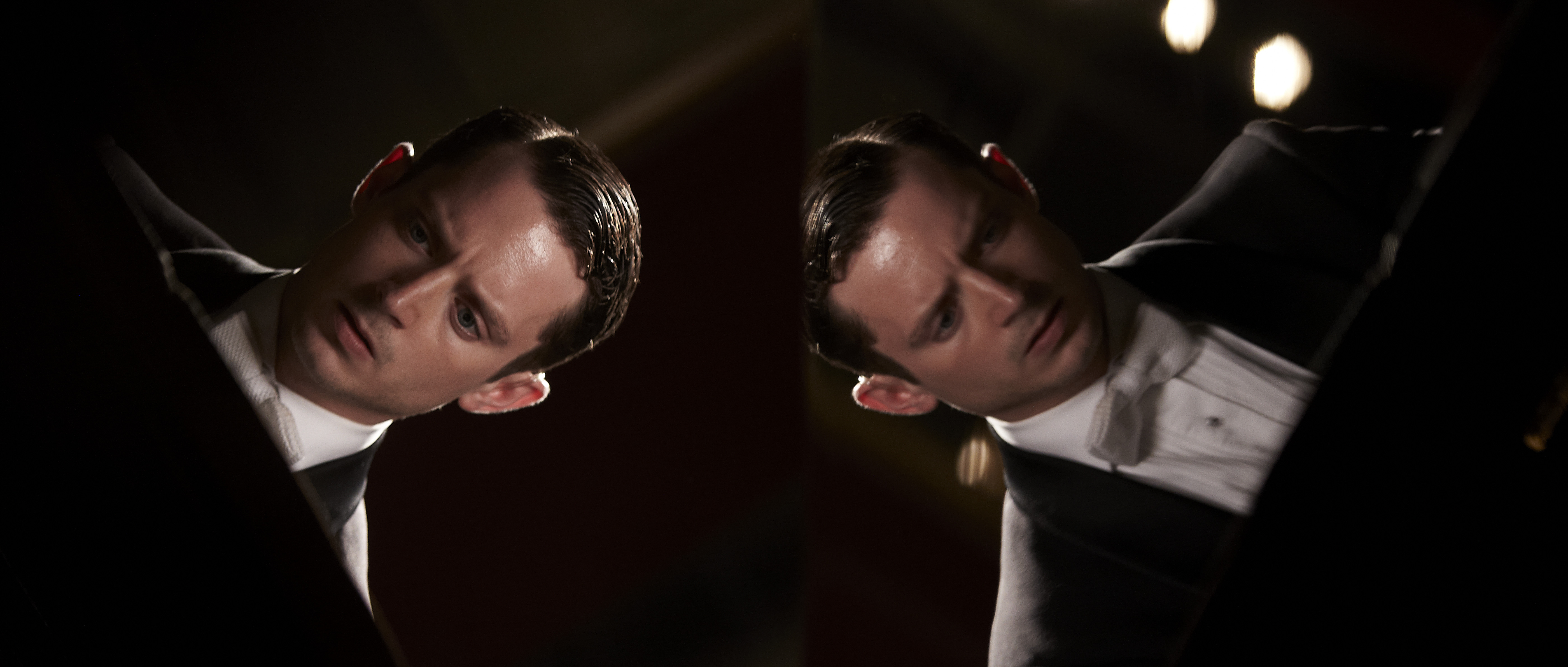
Grand Piano's Pulpy Love of High & Low
In Eugenio Mira’s “Grand Piano” renowned concert pianist Tom Selznick (Elijah Wood) reemerges from early retirement after he chokes during a concert attempting to play the “Unplayable Piece” by his mentor Patrick Godureaux. Following Patrick’s death, Tom is convinced by his star actress wife Emma (Kerry Bishé) to return to the stage playing Patrick’s piano in his remembrance. Hesitant to bring shame to his mentor, Tom experiences intense anxiety made more pressing by media inquires and some hazing from the orchestra. (They call him Failznick! Get it!?) Tom takes the stage to find a note written in his sheet music threatening both he and Emma. Tom has until the end of his performance to uncover the mystery menace and save his unsuspecting wife…
*Close-up on a guy saying*:
“We don’t have five minutes!”
Sounding a lot like something you would come up with your friends after one too many, “Grand Piano” is a wonderfully hokey, near tour-de-force flick that gleefully wallows in its own cinematic form. In earnest, it is a film more about staging, setting, and art than it’s plot. Mira’s direction and some keenly observed performances from the cast balance the hilarious flamboyance of the situation. The camerawork on display is a feast of techniques and framing styles without becoming gluttonous. Borrowing from giallo, other Euro-thriller and horror film, as well as a smattering of DePalma, the film bares itself like an old friend you haven’t seen in a while. Cinematographer Unax Mendía employees heavy saturation and stark geometric shapes to great effect. All the while the film winks at us only as much as it needs to.
If “Grand Piano” were a straightforward “psychological thriller” it would be better than average. But what makes the film stand out so completely is its complex take on the interaction of high art, low art, and the audience. Certainly there is a reliance on gimmick in that the film occurs within a closed space over a very specific period of time. Not that gimmick in this or any sense is meant to be disparaging or indicative of quality but this type of framing is for the most part associated with both “low” and “high” cinema. Think, for instance of “Bicycle Thieves”, “A Single Man”, Richard Linklater’s films, “Russian Ark”, “Timecode”, or any of the vast number of Slasher and horror films set over a single evening or even something like “24”. And though seemingly coincidental at first, this play between “high” and “low” is at the heart of “Grand Piano”. Indeed, Tom’s transition from terror-ridden to self-assured reflects the necessity of celebrating both the high and the low to create transcendent art.
When considering what drives Tom to return to the stage we find that there are two opposing yet complimentary forces. First, Tom must contend with his obligations to his paternal figure, Patrick. Tom is shaken by the oppressive obligation thrust upon him in the form of Patrick’s antique visage peering out from black and white photographs. This is orchestrated beautifully in the film’s opening moments as a plane Tom is on crests over Patrick’s mansion in the left of frame only to be swallowed up by a large sculpture of Patrick’s bust positioned in the foreground of frame right. We also first view Tom standing next to Patrick in a framed photograph as the piano is wheeled off in the reflective surface of the glass. This art is of the high brow, brought into such position through age as well as the orchestra’s cultural space. Emma, conversely, is the living voice that pushes him to return to the stage. She is a product of blockbuster Hollywood and the immediate visual consumption of her mainstream stardom, often implied as mass, low culture. This is insinuated not only in the constant media attention she endures but also the movie premiere we see her promoting, a sci-fi action adventure flick called “The Anger.” She is so directly instrumental in Tom’s return that she provides an introduction for him during a live radio interview he gives upon arriving in Chicago. What’s more, Emma gifts Tom a tablet with a card reading “Welcome to the 21st century”. We see in this gesture not her attempts to bring Tom out of a supposed antiquity (i.e. the orchestra) because she supports it, but an attempt to reawaken Tom to the possibilities of the present.
Eventually, the notes in Tom’s sheet music reveal that he and Emma are being held captive by a sniper named Clem (John Cusack) hidden somewhere in the theatre. With the help of an “Assistant” (Alex Winter), Clem intends on provoking Tom into perfectly playing Patrick’s “Unplayable Piece”, the same piece that resulted in his earlier meltdown. An eye in the auditorium, much like the audience we are viewing and the audience of which we are a part, Clem tells Tom that he is now Tom’s audience and he must not be disappointed. This relationship between Clem, the audience, and us is made more explicit through Mira’s focus on extras and supporting characters whose attention continually shifts between Tom on stage playing Patrick’s work and Emma, the sparkling starlet sitting in the box seats, and those small number of individuals aware of the situation unfolding. Through an assortment of graphic match edits, split screen distortions, and long takes, Mira begins to blur the lines between our subjective points of view. Whether or not Tom can actually play the piece carries the same emotional weight as the question of will he or won’t he make it out of this alive. This is beautifully illustrated in one single slow zoom out while Tom and his adversary converse, the sound transitioning from Tom’s perspective to Clem’s as the entirety of the auditorium comes into focus.
During the climatic moments of the film, Tom finds himself capable of performing the piece. However, at the very end, he chooses to play a deliberately wrong note stating that the audience never knows the difference. The orchestra attendees erupt in applause while Tom encourages Emma to come forward and sing a duet. And while the gesture may appear to be a middle finger to those in the theater seats the eventual resolution that follows is more concerned with the experience of witnessing this performance rather than it’s flawless execution. Rather than repeating an impossible, iconic event, Tom’s performance incorporates the present and the past, ultimately saving him from the threat at hand. Mira makes the point explicit during the final resolution as Tom stands before the piano as a steady rainfall is heard. The sound echoes the applause that came previous, waiting for Tom to succeed perfectly…or not.
The play between new and old, high and low, isn’t particularly ground breaking. It could be argued that this relationship is precisely why many of us seek out the paracinematic whether that be in the cinema or on television. But what is so accomplished in “Grand Piano” is Mira’s ability to make this interaction refreshing and vibrant again. Indeed, it is only because this interaction exists that Tom is capable of playing the “Unplayable Piece.” It is an atypical, typical film that relishes its broad strokes with a tenacity and joy that is completely infectious.

